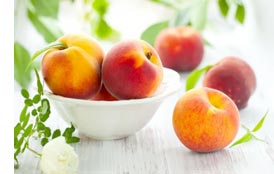Summer’s Nectar: Stone Fruit
- By Rebecca Taggart
- Reading Time: 3 mins.

The sweet smell of peaches at farmer’s markets heralds the official arrival of summer. Stone fruit season is here! Nothing captures the golden light of summer like the varied hues of apricots and nectarines, and nothing expresses summer’s voluptuousness like plums and cherries. Rich and delicious, stone fruit also packs a nutritional punch: it’s full of antioxidants, vitamins, and fiber.
Stone fruit can refer to all fruits with a hard pit in the center, including apricots, peaches, nectarines, cherries, and plums. Nectarines are the same species as peaches. But unlike peaches, nectarines have smooth skin, instead of furry skin, due to a naturally occurring recessive gene. Almonds are also part of the genus prunus in this closely-related family and differ only in that the seed rather than the flesh of the fruit is eaten.
Want fruit for your office?
Get your office a free sample TODAY!Dare to Eat a Peach?
Nutritionally, peaches, and nectarines are similar. Like all stone fruit, they are low in calories and fat, but high in vitamins A and C as well as fiber. The American Heart Association (AHA) recommends eating fresh peaches for heart health, in part due to their levels of beta carotene (an antioxidant precursor of vitamin A), which helps prevent atherosclerosis, and their fiber content, which lowers cholesterol.

Stone fruit is generally high in phytochemicals and antioxidants, with yellow- and red-fleshed varieties exhibiting higher levels than white-fleshed varieties, according to a 2004 study by researchers at Texas A&M University. Antioxidants reduce levels of free radicals in the body resulting from oxidation reactions. These free radicals cause oxidative stress, which appears to be an important cause and consequence of many human diseases, and one of the possible mechanisms of aging.
Life Is Better With a Bowl of Cherries
Need more inducement to bite into a luscious, ripe red cherry? Cherry anthocyanins, a class of phytochemical red pigments, have been shown in preliminary research to both prevent genetic mutations that could lead to cancer and reduce cancer cell growth. Sweet (i.e., eating) cherries offer nearly three times as many anthocyanins as tart (i.e., cooking) cherries, with two-thirds found in the skin. As cherries ripen, they produce more antioxidants, so select the darkest red cherries for the most benefits. In addition, one cup of sweet cherries pack the potassium of a small banana and also boasts some quercetin, the red-wine antioxidant that appears to keep blood vessels healthy
Plums also have high concentrations of antioxidants and increase our body’s ability to absorb iron.
Succulent peaches and nectarines, juicy plums, lip-smacking apricots, and delightfully red cherries are as healthy as they are irresistible. The only downside: These fragile fruits have a limited growing season, and local varieties won’t be around forever, so grab a bowlful while you can. No time to eat them all? Pit and halve stone fruit, then freeze on a baking sheet and seal in a freezer bag to use later for baking and smoothies.
Get tips for your office
Be an office hero!Rebecca Taggart is a San Francisco writer, teacher, and yoga instructor.


